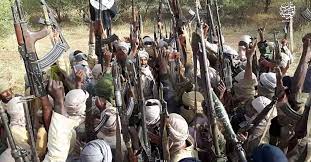The sahel jihadists’ communication strategy shows an impressive capacity for mobilization.
By Abdou Cisse
Islamic State (IS) caliph Abu al-Hasan al-Hashimi al-Qurachi, who was killed in action in the Syrian-Iraqi area, has been replaced by Abu al-Hussein al-Husseini al-Qurachi, according to an audio message from the jihadist organization’s spokesman released Wednesday, November 30.
In the nearly ten-minute audio, Abu Omar al-Muhajir urged IS supporters to pledge allegiance to the new leader, described as a “veteran of jihad.”
In the wake of this announcement, the various “provinces” of the jihadist organization took action, starting with Nigeria, in West Africa.
In Africa’s most populous country, the allegiances relayed by the Islamic State’s propaganda channels are made from six districts, mainly in the north-east.
The Sahelian branch erected as a “province” last March also mobilized several dozen armed fighters for the “allegiance ceremony” in the south of Menaka, on the border between Mali and Niger, but also in the Malian Gourma area.
Show of force
“The message from IS Sahel is clear: They want to make a show of force by displaying their large number, but also that they enjoy freedom of movement as evidenced by the long and winding convoys and large gatherings in the open field,” says Heni Nsaibi, a researcher at the Armed Conflict Location and Event Data Project.
According to Rida Lyammouri, a research associate at the Moroccan think tank, Policy Center for the News South (PCNS), “IS Sahel has seized this opportunity to consolidate its rise to power, which began a few months ago in the regions of Gao and Menaka, in Mali.
In these two regions of northern Mali, the jihadists are suspected by human rights organizations of abuses against civilians of the Tuareg tribe of Daoussahak.
They are also engaged in a fratricidal war with the ‘Groupe de Soutien à l’Islam et aux Musulmans’ (GSIM), the other jihadist group based in the region but affiliated with the rival Al Qaeda in the Islamic Maghreb (AQIM).
As in Nigeria, the jihadist organization’s communication shows an impressive ease of mobilization with hundreds of foot soldiers moving around on motorcycles without being bothered by the countries’ defense and security forces, as evidenced by images posted on social media by the jihadists themselves.
“It is easy for them to move around in large numbers because there are currently no opponents capable of worrying them imminently in the areas concerned,” H”ni Nsaibi explains, stressing the impact of the departure of French forces from Mali.
In the Malian Liptako, as well as in the Burkinabe and Malian Gourma areas, French forces have left and are only intervening on the Burkinabe side, in particular circumstances,” he adds.
French president Emmanuel Macron announced the “official end of Barkhane” on Wednesday, November 9, against the backdrop of a diplomatic crisis with Mali, which has been led by the military since May 2021.
Rida Lyammouri also maintains that the Islamic State affiliate benefits from the “vacuum left by Operation Barkhane in Mali and the political instability in Burkina Faso.”
In Mali, “the presence of the army and its partners from the controversial Russian private military company Wagner is limited to urban areas, while the militias cannot do much more than pick up animals that are roaming around,” Nsaibia insists.
AC/Los/fss/as/APA


